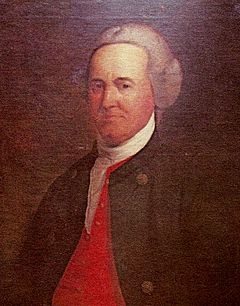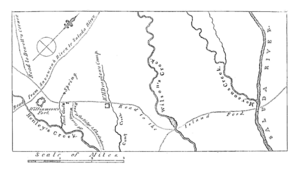Siege of Savage's Old Fields facts for kids
Quick facts for kids Siege of Savage's Old Fields |
|||||||
|---|---|---|---|---|---|---|---|
| Part of the American Revolutionary War | |||||||
 General Richard Richardson |
|||||||
|
|||||||
| Belligerents | |||||||
| Commanders and leaders | |||||||
| Andrew Williamson | Patrick Cuningham Joseph Robinson |
||||||
| Strength | |||||||
| 560 militia | 1,900 militia | ||||||
| Casualties and losses | |||||||
| 1 killed 12 wounded |
4 killed 20 wounded |
||||||
The siege of Savage's Old Fields (also known as the first siege of Ninety Six) happened from November 19 to 21, 1775. It was an early battle in the American Revolutionary War between American colonists who wanted independence (called Patriots) and those who stayed loyal to the British King (called Loyalists). This fight took place in a town called Ninety Six, South Carolina.
This event was the first big battle in South Carolina during the war. Before this, some military forts had been taken without any fighting. Patriot forces, led by Major Andrew Williamson, went to the area to get back gunpowder and ammunition. This supply was meant for the Cherokee people but had been taken by Loyalists. Williamson's group, about 500 strong, built a small fort near Ninety Six. They were then surrounded by about 1,900 Loyalists. The siege ended in a tie after two days. The Loyalists left, having lost 4 killed and 20 wounded. The Patriots lost 1 killed and 12 wounded. Both sides then pulled back.
Contents
Why the Fight Started: Background to the Siege
When the American Revolutionary War began in Massachusetts in April 1775, people in South Carolina had different ideas. Many English people living near the coast supported the rebellion or stayed neutral. However, many people in the back country, including German and Scottish immigrants, were against it. A strong Loyalist leader in the back country was Thomas Fletchall. He openly opposed the Patriots who wanted to resist the King and Parliament. By August 1775, tensions grew, and both sides formed large groups of local soldiers called militia.
For a while, things were mostly peaceful, but people were very tense. Both sides wanted to control weapons and supplies. In early August, the Council of Safety (a Patriot group) sent William Henry Drayton and Reverend William Tennent to Ninety Six. Their goal was to get more Patriot support and stop the Loyalists. Drayton managed to make a shaky peace agreement with Fletchall in September.
On September 15, Patriot militia took over Fort Johnson. This was a main fort watching over the Charleston harbor. Governor William Campbell then closed the local government. Fearing for his safety, he escaped to a British navy ship. This left the Patriot Council of Safety in charge of the capital city. The council started making Charleston's defenses stronger. Later, on November 11 and 12, there was a small, bloodless exchange of cannon fire between Patriots and British ships.
Things got worse after Loyalists took a shipment of gunpowder and ammunition in October. This supply was sent by the Council of Safety for the Cherokee people. The council decided to send a large group to get the supplies back. On November 8, they voted to send Colonel Richard Richardson to recover the shipment and arrest Loyalist leaders.
The Siege of Savage's Old Fields
While Colonel Richardson gathered his forces, Major Andrew Williamson was already recruiting soldiers in the back country. He heard about the gunpowder being taken. Williamson arrived at Ninety Six on November 19 with 560 men. He found the small town hard to defend. So, he set up a camp on John Savage's farm. This spot gave his three small cannons, called swivel guns, a clear view to fire. He started building a simple wooden fence, or stockade, around the camp.
Loyalist recruiting had been more successful. Williamson learned that Captain Patrick Cuningham and Major Joseph Robinson were leading a large Loyalist force of about 1,900 men toward Ninety Six. In a meeting that day, the Patriot leaders decided not to march out and fight the Loyalists in the open. The Loyalists arrived the next day and surrounded the Patriot camp.
The leaders of both sides were trying to talk and end the standoff. But then, two Patriot soldiers were captured by Loyalists outside the fort. This started a gunfight that lasted about two hours. The next morning, both sides started shooting at each other from a distance. The Loyalists tried to start fires to create smoke. They hoped this smoke would hide them as they got closer to the fort. But the ground was wet, and this plan failed. The Loyalists then built a big wooden shield. They tried to use it to bring fire-starting tools closer to the fort. However, they accidentally set their own shield on fire, and it didn't protect them from the Patriot guns.
On the afternoon of November 21, the Patriots held a meeting. They decided to make a surprise attack, or sortie, that night. As they got ready, a Loyalist approached with a white flag, asking to talk. Nothing was decided then, but they agreed to meet the next morning. In that meeting, the Loyalists agreed to move back across the Saluda River. The Patriots agreed to destroy their fort. Both sides also agreed to return any prisoners taken since November 2. They also promised not to stop each other from sending messages to their leaders. The Patriot leaders also had to give up their swivel guns, but they got them back three days later. The truce also mentioned that neither side would bring in more soldiers. However, the Patriot Council of Safety said this rule didn't apply to Colonel Richardson's approaching force.
What Happened Next: Aftermath of the Siege
We don't know exactly why the Loyalists chose to make a truce. Governor Campbell said the Loyalists didn't have strong leaders. Some historians think it might have been because Colonel Richardson was getting ready to attack with many soldiers. Richardson gathered 2,500 men, and by the end of November, he had more than 4,000. This large force searched the back country. They arrested or chased away most of the Loyalist leaders. This campaign mostly ended on December 22, when 15 inches (38 cm) of snow fell. Richardson's men were not ready for the snow and had a very hard trip back to the lowlands.
Some Loyalist leaders, like Thomas Brown, escaped Richardson's group. They fled to West Florida and joined British forces there. These events largely ended big Loyalist actions in the southern Appalachian Mountains. However, the fighting, which was like a civil war in many ways, became much more brutal in the years that followed. Ninety Six became a British outpost after the 1780 siege of Charleston. It was later attacked in 1781 by forces led by Nathanael Greene. Even though Greene had to stop his attack because British help was coming, the British left Ninety Six soon after.
Who Fought: Order of Battle
Here's a look at the groups that fought in the siege:
- Patriots:
* Commander: Major Andrew Williamson of the Ninety-Six District Regiment of Militia. * Many different groups of local soldiers (militia) from various districts in South Carolina and even a small group from North Carolina. * These included detachments from the Ninety-Six District Regiment, Little River District Regiment, Camden District Regiment, and others. * Several Independent Companies of Rangers also took part.
- British/Loyalists:
* About 1,892 Loyalists led by Major Joseph Robinson. * These were mainly the Ninety-Six District Loyalist Militia and the New Acquisition Regiment.
See also
- American Revolutionary War §Early Engagements. This link shows where the siege of Savage's Old Fields fits into the bigger picture of the war.


